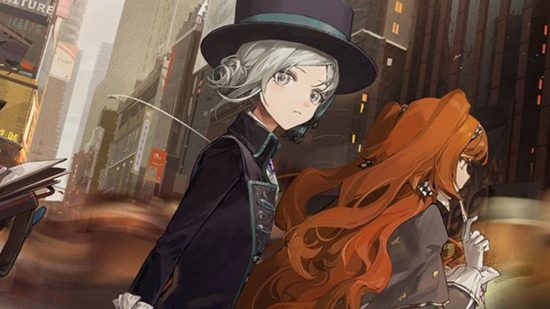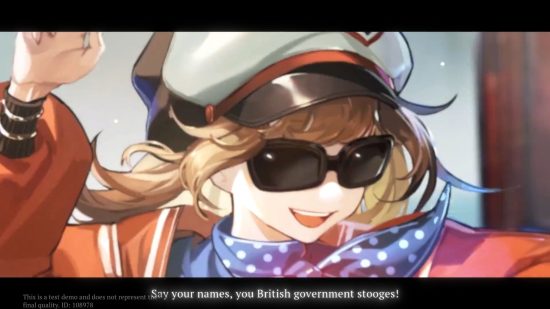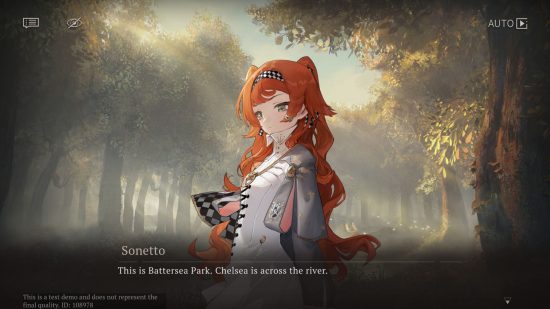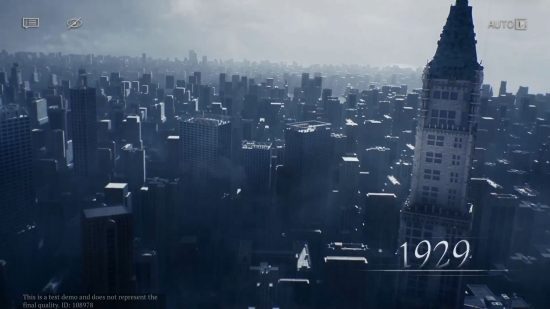Reverse: 1999 is an upcoming gacha game from Bluepoch, with RPG elements and a visual novel-esque storytelling style. It has gorgeous graphics, really stylish character designs, and a bold setting, all of which make it stand out from the large crowd it’s jumping into. But the way it presents its story is absolutely baffling.
As you’ll likely expect, there’s a wide cast of characters to collect, as well as stars of the show that feature in lengthy story sections. Scattered throughout these story sections are turn-based battles that make use of a reasonably intriguing card system, likely the most engaging part of the game.
During a battle, you have a row of cards at the bottom, each ascribed to one of your characters. They line up in a random order, but you can use whichever card you like. If you get two cards of the same type next to each other in the row at the bottom, they combine together into a stronger form, sort of like a match-three puzzle.
This adds a fun and simple bit of decision making to which cards you engage. In the first three chapters I got to play, there wasn’t really a challenge at all, so to at least feel some direction thanks to this system is quite nice. I’d assume things get more difficult as the game goes on, as the game definitely needs it to make building out groups of characters a little more engaging.
Throughout these battles, there are exciting animations when you pull off a special move – something you can do once a meter charges up – alongside pleasant 3D character models, smaller and cuter than their VN-style counterparts. It all looks good, and it all runs smoothly on my base model tenth-gen iPad. It’s slick.
But battles aren’t really the most important thing in Reverse: 1999. Arguably, the most important aspect is the overall aesthetic. You’re introduced to the world with a loud cutscene featuring Regulus, a British woman who runs a pirate radio station and loves music from the likes of Pete Windmill and John Thunderfingers. It’s mighty charming.
She has these masked characters tied up, both of whom look like some futuristic missionaries, before a massive explosion hits her ship and a quick escape is needed. It’s not really clear what’s going on, and that sort of stays the same for the rest of the first few chapters.
Through all this hullabaloo, we meet ourselves, as it were, as we play the character of the Timekeeper. We meet Sonetto, a woman who works for an organization trying to deal with The Storm, a moment where raindrops fall upwards and time is turned backwards. The challenge of dealing with this disaster takes you back to the Jazz Age, forward to the Swinging Sixties, and likely to even more faraway places.
London is offered up in an amusing way. It’s 1966, and all these out-of-place characters talk of areas like Battersea Park, Chelsea, and Carnaby Street. There’s even chat of Hoover upright vacuum cleaners in the West End. It’s an incredibly intriguing clash.
A chapter later, and you’re in New York. It’s 1929, and the streets are full of foul-mouthed ruffians looking for a fight. Now, I don’t really know why we’re here; in fact, it’s not explained at all. And before you know it, you’re somewhere else again.
For all these charming features, the deeper you get into the game, the more of a confusing jumble it all becomes. It’s just a pile of place names and proper nouns, and it never coheres together. Perhaps it will later in the game, but for all I’ve seen, it feels like ChatGPT could’ve written the scenario.
I’d suspect this is because something is lost in translation. While everything is voice-acted in English admirably, it feels like you can hear the actors’ confusion at some lines. Just take this, for example: “I did not expect that there is such a big place in your suitcase. I never knew it before.” This is spoken aloud in a group, one of whom is a high-brow floating apple called APPLe. It’s baffling.
Still, I don’t think Reverse: 1999 takes itself as seriously as first impressions may suggest – there may be some comedy in it all that’s lost in translation. Just taking a quick look at the different characters you can summon makes the game feel purposefully silly, rather than just a pile of nonsense. There’s a scarecrow called Rabies, a well-spoken shard of a mirror called Door, and Sputnik, literally just the Sputnik 1 earth satellite. It’s all very odd but in an amusing way.
There’s something here, but whether it can cohere is still to be seen. The various disparate parts don’t tie together, we just jump around them all without anything really making any sense. Hopefully the enjoyable battle mechanics, rich art and character designs, and overall silliness of it all can carry you through to something better, but we can’t promise there’s anything on the other side – we’ve seen no sign of it yet.



